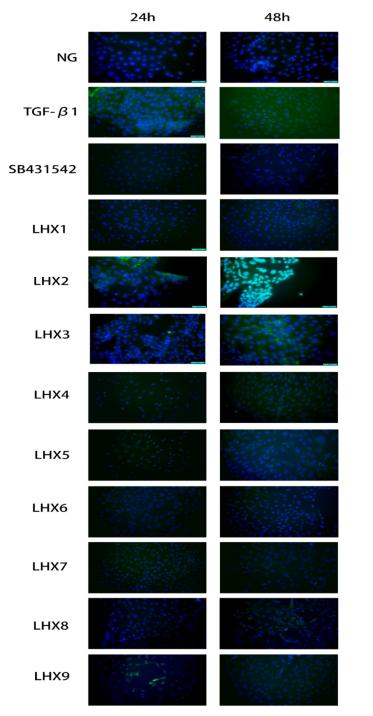LHX1 Antibody - #DF4823
| Product: | LHX1 Antibody |
| Catalog: | DF4823 |
| Description: | Rabbit polyclonal antibody to LHX1 |
| Application: | WB IHC IF/ICC |
| Reactivity: | Human, Mouse, Rat |
| Prediction: | Pig, Zebrafish, Bovine, Horse, Sheep, Rabbit, Dog, Chicken, Xenopus |
| Mol.Wt.: | 44 KD; 45kD(Calculated). |
| Uniprot: | P48742 |
| RRID: | AB_2837188 |
Related Downloads
Protocols
Product Info
*The optimal dilutions should be determined by the end user.
*Tips:
WB: For western blot detection of denatured protein samples. IHC: For immunohistochemical detection of paraffin sections (IHC-p) or frozen sections (IHC-f) of tissue samples. IF/ICC: For immunofluorescence detection of cell samples. ELISA(peptide): For ELISA detection of antigenic peptide.
Cite Format: Affinity Biosciences Cat# DF4823, RRID:AB_2837188.
Fold/Unfold
hLim-1; Homeo box protein Lim 1; Homeo box protein Lim1; Homeobox protein Lim 1; Homeobox protein Lim-1; Homeobox protein Lim1; LHX 1; LHX1; LHX1_HUMAN; LIM 1; LIM homeo box 1; LIM homeo box protein 1; LIM homeobox 1; LIM homeobox protein 1; LIM-1; LIM/homeobox protein Lhx 1; LIM/homeobox protein Lhx1; MGC126723; MGC138141;
Immunogens
Expressed in the brain, thymus, and tonsils. Expressed in samples from patients with chronic myeloid leukemia (CML) and in 58% of acute myeloid leukemia (AML) cell lines.
- P48742 LHX1_HUMAN:
- Protein BLAST With
- NCBI/
- ExPASy/
- Uniprot
MVHCAGCKRPILDRFLLNVLDRAWHVKCVQCCECKCNLTEKCFSREGKLYCKNDFFRCFGTKCAGCAQGISPSDLVRRARSKVFHLNCFTCMMCNKQLSTGEELYIIDENKFVCKEDYLSNSSVAKENSLHSATTGSDPSLSPDSQDPSQDDAKDSESANVSDKEAGSNENDDQNLGAKRRGPRTTIKAKQLETLKAAFAATPKPTRHIREQLAQETGLNMRVIQVWFQNRRSKERRMKQLSALGARRHAFFRSPRRMRPLVDRLEPGELIPNGPFSFYGDYQSEYYGPGGNYDFFPQGPPSSQAQTPVDLPFVPSSGPSGTPLGGLEHPLPGHHPSSEAQRFTDILAHPPGDSPSPEPSLPGPLHSMSAEVFGPSPPFSSLSVNGGASYGNHLSHPPEMNEAAVW
Predictions
Score>80(red) has high confidence and is suggested to be used for WB detection. *The prediction model is mainly based on the alignment of immunogen sequences, the results are for reference only, not as the basis of quality assurance.
High(score>80) Medium(80>score>50) Low(score<50) No confidence
PTMs - P48742 As Substrate
| Site | PTM Type | Enzyme | Source |
|---|---|---|---|
| K48 | Sumoylation | Uniprot | |
| S71 | Phosphorylation | Uniprot | |
| S162 | Phosphorylation | Uniprot |
Research Backgrounds
Potential transcription factor. May play a role in early mesoderm formation and later in lateral mesoderm differentiation and neurogenesis.
Nucleus.
Expressed in the brain, thymus, and tonsils. Expressed in samples from patients with chronic myeloid leukemia (CML) and in 58% of acute myeloid leukemia (AML) cell lines.
Interacts with LDB1 via the tandem LIM domains.
The LIM domains exert a negative regulatory function and disruption of the LIM domains produces an activated form. In addition, two activation domains and a negative regulatory domain exist C-terminally to the homeobox (By similarity).
References
Application: IF/ICC Species: Mouse Sample: MTEC cells
Application: WB Species: Human Sample:
Application: IF/ICC Species: Human Sample:
Restrictive clause
Affinity Biosciences tests all products strictly. Citations are provided as a resource for additional applications that have not been validated by Affinity Biosciences. Please choose the appropriate format for each application and consult Materials and Methods sections for additional details about the use of any product in these publications.
For Research Use Only.
Not for use in diagnostic or therapeutic procedures. Not for resale. Not for distribution without written consent. Affinity Biosciences will not be held responsible for patent infringement or other violations that may occur with the use of our products. Affinity Biosciences, Affinity Biosciences Logo and all other trademarks are the property of Affinity Biosciences LTD.





